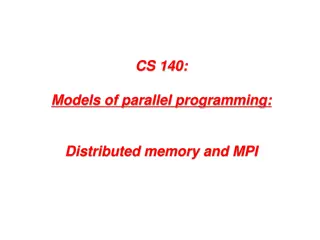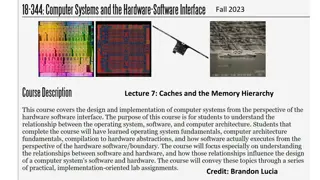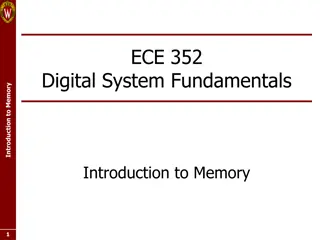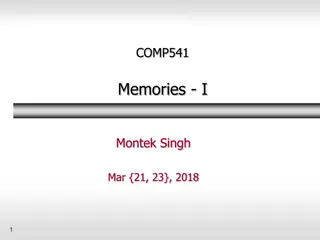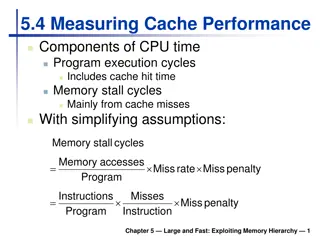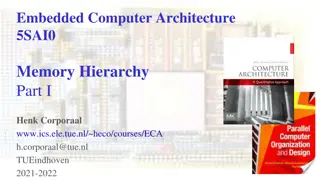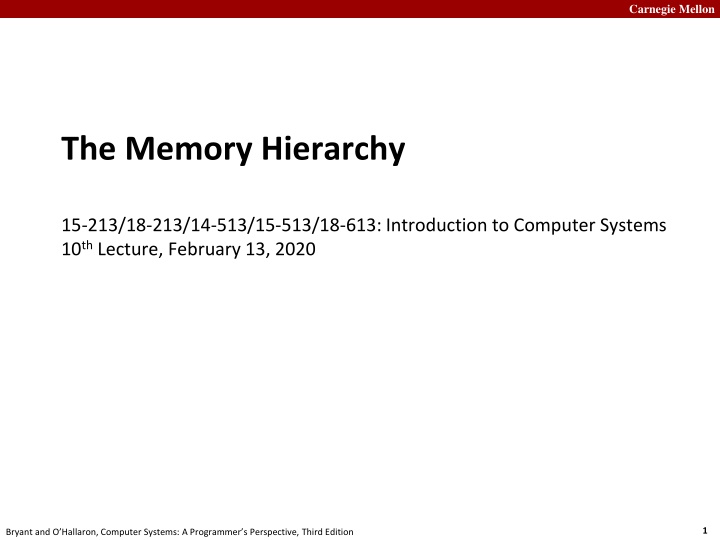
Carnegie Mellon's Memory Hierarchy and Computer Systems
Explore the memory hierarchy, storage technologies, and traditional bus structure as discussed in Carnegie Mellon's lectures on computer systems. Learn about memory transactions, bus connections, and data transfer processes within computer systems. Gain insights into memory read operations and the role of various components in the memory abstraction process.
Download Presentation

Please find below an Image/Link to download the presentation.
The content on the website is provided AS IS for your information and personal use only. It may not be sold, licensed, or shared on other websites without obtaining consent from the author. If you encounter any issues during the download, it is possible that the publisher has removed the file from their server.
You are allowed to download the files provided on this website for personal or commercial use, subject to the condition that they are used lawfully. All files are the property of their respective owners.
The content on the website is provided AS IS for your information and personal use only. It may not be sold, licensed, or shared on other websites without obtaining consent from the author.
E N D
Presentation Transcript
Carnegie Mellon The Memory Hierarchy 15-213/18-213/14-513/15-513/18-613: Introduction to Computer Systems 10thLecture, February 13, 2020 1 Bryant and O Hallaron, Computer Systems: A Programmer s Perspective, Third Edition
Carnegie Mellon Today The memory abstraction RAM : main memory building block Locality of reference The memory hierarchy Storage technologies and trends 2 Bryant and O Hallaron, Computer Systems: A Programmer s Perspective, Third Edition
Carnegie Mellon Writing & Reading Memory Write Transfer data from CPU to memory movq 8(%rsp),%rax Store operation Read Transfer data from memory to CPU movq %rax, 8(%rsp) Load operation From 5th lecture 3 Bryant and O Hallaron, Computer Systems: A Programmer s Perspective, Third Edition
Carnegie Mellon Traditional Bus Structure Connecting CPU and Memory A bus is a collection of parallel wires that carry address, data, and control signals. Buses are typically shared by multiple devices. CPU chip Register file ALU System bus Memory bus Main memory I/O bridge Bus interface 4 Bryant and O Hallaron, Computer Systems: A Programmer s Perspective, Third Edition
Carnegie Mellon Memory Read Transaction (1) CPU places address A on the memory bus. Register file Load operation: movq A, %rax ALU %rax Main memory 0 I/O bridge A Bus interface A x 5 Bryant and O Hallaron, Computer Systems: A Programmer s Perspective, Third Edition
Carnegie Mellon Memory Read Transaction (2) Main memory reads A from the memory bus, retrieves word x, and places it on the bus. Register file Load operation: movq A, %rax ALU %rax Main memory 0 I/O bridge x Bus interface A x 6 Bryant and O Hallaron, Computer Systems: A Programmer s Perspective, Third Edition
Carnegie Mellon Memory Read Transaction (3) CPU read word x from the bus and copies it into register %rax. Register file Load operation: movq A, %rax ALU %rax x Main memory 0 I/O bridge Bus interface A x 7 Bryant and O Hallaron, Computer Systems: A Programmer s Perspective, Third Edition
Carnegie Mellon Memory Write Transaction (1) CPU places address A on bus. Main memory reads it and waits for the corresponding data word to arrive. Register file Store operation: movq %rax, A ALU %rax y Main memory 0 I/O bridge A Bus interface A 8 Bryant and O Hallaron, Computer Systems: A Programmer s Perspective, Third Edition
Carnegie Mellon Memory Write Transaction (2) CPU places data word y on the bus. Register file Store operation: movq %rax, A ALU %rax y Main memory 0 I/O bridge y Bus interface A 9 Bryant and O Hallaron, Computer Systems: A Programmer s Perspective, Third Edition
Carnegie Mellon Memory Write Transaction (3) Main memory reads data word y from the bus and stores it at address A. Register file Store operation: movq %rax, A ALU %rax y Main memory 0 I/O bridge Bus interface A y 10 Bryant and O Hallaron, Computer Systems: A Programmer s Perspective, Third Edition
Carnegie Mellon Today The memory abstraction RAM : main memory building block Locality of reference The memory hierarchy Storage technologies and trends 11 Bryant and O Hallaron, Computer Systems: A Programmer s Perspective, Third Edition
Carnegie Mellon Random-Access Memory (RAM) Key features RAM is traditionally packaged as a chip. or embedded as part of processor chip Basic storage unit is normally a cell (one bit per cell). Multiple RAM chips form a memory. RAM comes in two varieties: SRAM (Static RAM) DRAM (Dynamic RAM) 12 Bryant and O Hallaron, Computer Systems: A Programmer s Perspective, Third Edition
Carnegie Mellon RAM Technologies DRAM SRAM 6 transistors / bit 1 Transistor + 1 capacitor / bit Capacitor oriented vertically Holds state indefinitely Must refresh state periodically 13 Bryant and O Hallaron, Computer Systems: A Programmer s Perspective, Third Edition
Carnegie Mellon SRAM vs DRAM Summary Trans. Access Needs Needs per bit time refresh? EDC? Cost Applications SRAM 6 or 8 1x No Maybe 100x Cache memories DRAM 1 10x Yes Yes 1x Main memories, frame buffers EDC: Error detection and correction Trends SRAM scales with semiconductor technology Reaching its limits DRAM scaling limited by need for minimum capacitance Aspect ratio limits how deep can make capacitor Also reaching its limits 14 Bryant and O Hallaron, Computer Systems: A Programmer s Perspective, Third Edition
Carnegie Mellon Enhanced DRAMs Operation of DRAM cell has not changed since its invention Commercialized by Intel in 1970. DRAM cores with better interface logic and faster I/O : Synchronous DRAM (SDRAM) Uses a conventional clock signal instead of asynchronous control Double data-rate synchronous DRAM (DDR SDRAM) Double edge clocking sends two bits per cycle per pin Different types distinguished by size of small prefetch buffer: DDR (2 bits), DDR2 (4 bits), DDR3 (8 bits), DDR4 (16 bits) By 2010, standard for most server and desktop systems Intel Core i7 supports DDR3 and DDR4 SDRAM 15 Bryant and O Hallaron, Computer Systems: A Programmer s Perspective, Third Edition
Carnegie Mellon Conventional DRAM Organization d x w DRAM: d w total bits organized as d supercells of size w bits 16 x 8 DRAM chip cols 0 1 2 3 2 bits / 0 addr 1 rows Memory controller supercell (2,1) 2 (to/from CPU) 3 8 bits / data Internal row buffer 16 Bryant and O Hallaron, Computer Systems: A Programmer s Perspective, Third Edition
Carnegie Mellon Reading DRAM Supercell (2,1) Step 1(a): Row access strobe (RAS) selects row 2. Step 1(b): Row 2 copied from DRAM array to row buffer. 16 x 8 DRAM chip Cols 0 1 2 3 RAS = 2 2 / 0 addr 1 Rows Memory controller 2 3 8 / data Internal row buffer 17 Bryant and O Hallaron, Computer Systems: A Programmer s Perspective, Third Edition
Carnegie Mellon Reading DRAM Supercell (2,1) Step 2(a): Column access strobe (CAS) selects column 1. Step 2(b): Supercell (2,1) copied from buffer to data lines, and eventually back to the CPU. Step 3: All data written back to row to provide refresh 16 x 8 DRAM chip Cols 0 1 2 3 CAS = 1 2 / 0 addr To CPU 1 Rows Memory controller 2 supercell (2,1) 3 8 / data supercell (2,1) Internal row buffer 18 Bryant and O Hallaron, Computer Systems: A Programmer s Perspective, Third Edition
Carnegie Mellon Memory Modules addr (row = i, col = j) : supercell (i,j) DRAM 0 64 MB memory module consisting of eight 8Mx8 DRAMs DRAM 7 bits 56-63 bits 48-55 bits 40-47 bits 32-39 bits 24-31 bits 16-23 bits 8-15 bits 0-7 63 63 56 56 55 55 48 48 47 47 40 40 39 39 32 32 31 31 24 24 23 23 16 16 15 15 8 8 7 7 0 0 Memory controller 64-bit word main memory address A 64-bit word 19 Bryant and O Hallaron, Computer Systems: A Programmer s Perspective, Third Edition
Carnegie Mellon Today The memory Abstraction DRAM : main memory building block Locality of reference The memory hierarchy Storage technologies and trends 20 Bryant and O Hallaron, Computer Systems: A Programmer s Perspective, Third Edition
Carnegie Mellon The CPU-Memory Gap The gap widens between DRAM, disk, and CPU speeds. 100,000,000.0 10,000,000.0 Disk 1,000,000.0 SSD 100,000.0 Disk seek time SSD access time DRAM access time SRAM access time CPU cycle time Effective CPU cycle time 10,000.0 Time (ns) 1,000.0 DRAM 100.0 10.0 1.0 CPU 0.1 0.0 1985 1990 1995 2000 2003 2005 2010 2015 Year 21 Bryant and O Hallaron, Computer Systems: A Programmer s Perspective, Third Edition
Carnegie Mellon Locality to the Rescue! The key to bridging this CPU-Memory gap is a fundamental property of computer programs known as locality. 22 Bryant and O Hallaron, Computer Systems: A Programmer s Perspective, Third Edition
Carnegie Mellon Locality Principle of Locality: Programs tend to use data and instructions with addresses near or equal to those they have used recently Temporal locality: Recently referenced items are likely to be referenced again in the near future Spatial locality: Items with nearby addresses tend to be referenced close together in time 23 Bryant and O Hallaron, Computer Systems: A Programmer s Perspective, Third Edition
Carnegie Mellon Locality Example sum = 0; for (i = 0; i < n; i++) sum += a[i]; return sum; Spatial or Temporal Locality? Data references Reference array elements in succession (stride-1 reference pattern). Reference variable sum each iteration. spatial temporal Instruction references Reference instructions in sequence. Cycle through loop repeatedly. spatial temporal 24 Bryant and O Hallaron, Computer Systems: A Programmer s Perspective, Third Edition
Carnegie Mellon Qualitative Estimates of Locality Claim: Being able to look at code and get a qualitative sense of its locality is a key skill for a professional programmer. Question: Does this function have good locality with respect to array a? int sum_array_rows(int a[M][N]) { int i, j, sum = 0; Hint: array layout is row-major order for (i = 0; i < M; i++) for (j = 0; j < N; j++) sum += a[i][j]; return sum; } Answer: yes a a a a a a [0] [0] [0] [N-1] [1] [0] [1] [N-1] [M-1] [0] [M-1] [N-1] 25 Bryant and O Hallaron, Computer Systems: A Programmer s Perspective, Third Edition
Carnegie Mellon Locality Example Question: Does this function have good locality with respect to array a? int sum_array_cols(int a[M][N]) { int i, j, sum = 0; for (j = 0; j < N; j++) for (i = 0; i < M; i++) sum += a[i][j]; return sum; } Answer: no, unless M is very small a a a a a a [0] [0] [0] [N-1] [1] [0] [1] [N-1] [M-1] [0] [M-1] [N-1] 26 Bryant and O Hallaron, Computer Systems: A Programmer s Perspective, Third Edition
Carnegie Mellon Locality Example Question: Can you permute the loops so that the function scans the 3-d array awith a stride-1 reference pattern (and thus has good spatial locality)? int sum_array_3d(int a[M][N][N]) { int i, j, k, sum = 0; for (i = 0; i < N; i++) for (j = 0; j < N; j++) for (k = 0; k < M; k++) sum += a[k][i][j]; return sum; } Answer: make j the inner loop 27 Bryant and O Hallaron, Computer Systems: A Programmer s Perspective, Third Edition
Carnegie Mellon Today The memory abstraction DRAM : main memory building block Locality of reference The memory hierarchy Storage technologies and trends 28 Bryant and O Hallaron, Computer Systems: A Programmer s Perspective, Third Edition
Carnegie Mellon Memory Hierarchies Some fundamental and enduring properties of hardware and software: Fast storage technologies cost more per byte, have less capacity, and require more power (heat!). The gap between CPU and main memory speed is widening. Well-written programs tend to exhibit good locality. These fundamental properties complement each other beautifully. They suggest an approach for organizing memory and storage systems known as a memory hierarchy. 29 Bryant and O Hallaron, Computer Systems: A Programmer s Perspective, Third Edition
Carnegie Mellon Example Memory Hierarchy L0: Regs CPU registers hold words retrieved from the L1 cache. Smaller, faster, and costlier (per byte) storage devices L1 cache (SRAM) L1: L1 cache holds cache lines retrieved from the L2 cache. L2 cache (SRAM) L2: L2 cache holds cache lines retrieved from L3 cache. L3 cache (SRAM) L3: L3 cache holds cache lines retrieved from main memory. Larger, slower, and cheaper (per byte) storage devices L4: Main memory (DRAM) Main memory holds disk blocks retrieved from local disks. Local secondary storage (local disks) L5: Local disks hold files retrieved from disks on remote servers. Remote secondary storage (e.g., Web servers) L6: 30 Bryant and O Hallaron, Computer Systems: A Programmer s Perspective, Third Edition
Carnegie Mellon Caches Cache: A smaller, faster storage device that acts as a staging area for a subset of the data in a larger, slower device. Fundamental idea of a memory hierarchy: For each k, the faster, smaller device at level k serves as a cache for the larger, slower device at level k+1. Why do memory hierarchies work? Because of locality, programs tend to access the data at level k more often than they access the data at level k+1. Thus, the storage at level k+1 can be slower, and thus larger and cheaper per bit. Big Idea (Ideal): The memory hierarchy creates a large pool of storage that costs as much as the cheap storage near the bottom, but that serves data to programs at the rate of the fast storage near the top. 31 Bryant and O Hallaron, Computer Systems: A Programmer s Perspective, Third Edition
Carnegie Mellon General Cache Concepts Smaller, faster, more expensive memory caches a subset of the blocks Cache 8 4 9 14 10 3 Data is copied in block-sized transfer units 4 10 Larger, slower, cheaper memory viewed as partitioned into blocks Memory 0 1 2 3 4 4 5 6 7 8 9 10 10 11 12 13 14 15 32 Bryant and O Hallaron, Computer Systems: A Programmer s Perspective, Third Edition
Carnegie Mellon General Cache Concepts: Hit Data in block b is needed Request: 14 Block b is in cache: Hit! Cache 8 9 14 14 3 Memory 0 1 2 3 4 5 6 7 8 9 10 11 12 13 14 15 33 Bryant and O Hallaron, Computer Systems: A Programmer s Perspective, Third Edition
Carnegie Mellon General Cache Concepts: Miss Data in block b is needed Request: 12 Block b is not in cache: Miss! Cache 8 9 12 14 3 Block b is fetched from memory Request: 12 12 Block b is stored in cache Placement policy: determines where b goes Replacement policy: determines which block gets evicted (victim) Memory 0 1 2 3 4 5 6 7 8 9 10 11 12 12 13 14 15 34 Bryant and O Hallaron, Computer Systems: A Programmer s Perspective, Third Edition
Carnegie Mellon General Caching Concepts: 3 Types of Cache Misses Cold (compulsory) miss Cold misses occur because the cache starts empty and this is the first reference to the block. Capacity miss Occurs when the set of active cache blocks (working set) is larger than the cache. Conflict miss Most caches limit blocks at level k+1 to a small subset (sometimes a singleton) of the block positions at level k. E.g. Block i at level k+1 must be placed in block (i mod 4) at level k. Conflict misses occur when the level k cache is large enough, but multiple data objects all map to the same level k block. E.g. Referencing blocks 0, 8, 0, 8, 0, 8, ... would miss every time. 35 Bryant and O Hallaron, Computer Systems: A Programmer s Perspective, Third Edition
Carnegie Mellon Examples of Caching in the Mem. Hierarchy Cache Type What is Cached? Where is it Cached? Latency (cycles) Managed By Registers 4-8 byte words CPU core 0 Compiler TLB Address translations On-Chip TLB 0 Hardware MMU L1 cache 64-byte blocks On-Chip L1 4 Hardware L2 cache 64-byte blocks On-Chip L2 10 Hardware Virtual Memory 4-KB pages Main memory 100 Hardware + OS Buffer cache Parts of files Main memory 100 OS Disk cache Disk sectors Disk controller 100,000 Disk firmware Network buffer cache Parts of files Local disk 10,000,000 NFS client Browser cache Web pages Local disk 10,000,000 Web browser Web cache Web pages Remote server disks 1,000,000,000 Web proxy server 36 Bryant and O Hallaron, Computer Systems: A Programmer s Perspective, Third Edition
Carnegie Mellon Quiz Time! Check out: https://canvas.cmu.edu/courses/13182 37 Bryant and O Hallaron, Computer Systems: A Programmer s Perspective, Third Edition
Carnegie Mellon Today The memory abstraction RAM : main memory building block Locality of reference The memory hierarchy Storage technologies and trends 38 Bryant and O Hallaron, Computer Systems: A Programmer s Perspective, Third Edition
Carnegie Mellon Storage Technologies Nonvolatile (Flash) Memory Magnetic Disks Store as persistent charge Store on magnetic medium Implemented with 3-D structure 100+ levels of cells 3 bits data per cell Electromechanical access 39 Bryant and O Hallaron, Computer Systems: A Programmer s Perspective, Third Edition
Carnegie Mellon What s Inside A Disk Drive? Spindle Arm Platters Actuator Electronics (including a processor and memory!) SCSI connector Image courtesy of Seagate Technology 40 Bryant and O Hallaron, Computer Systems: A Programmer s Perspective, Third Edition
Carnegie Mellon Disk Geometry Disks consist of platters, each with two surfaces. Each surface consists of concentric rings called tracks. Each track consists of sectors separated by gaps. Tracks Surface Track k Gaps Spindle Sectors 41 Bryant and O Hallaron, Computer Systems: A Programmer s Perspective, Third Edition
Carnegie Mellon Disk Capacity Capacity: maximum number of bits that can be stored. Vendors express capacity in units of gigabytes (GB) or terabytes (TB), where 1 GB = 109 Bytes and 1 TB = 1012 Bytes Capacity is determined by these technology factors: Recording density (bits/in): number of bits that can be squeezed into a 1 inch segment of a track. Track density (tracks/in): number of tracks that can be squeezed into a 1 inch radial segment. Areal density (bits/in2): product of recording and track density. Tracks 42 Bryant and O Hallaron, Computer Systems: A Programmer s Perspective, Third Edition
Carnegie Mellon Disk Operation (Single-Platter View) The disk surface spins at a fixed rotational rate The read/write head is attached to the end of the arm and flies over the disk surface on a thin cushion of air. spindle spindle spindle spindle spindle By moving radially, the arm can position the read/write head over any track. 43 Bryant and O Hallaron, Computer Systems: A Programmer s Perspective, Third Edition
Carnegie Mellon Disk Operation (Multi-Platter View) Read/write heads move in unison from cylinder to cylinder Arm Spindle 44 Bryant and O Hallaron, Computer Systems: A Programmer s Perspective, Third Edition
Carnegie Mellon Disk Access Service Time Components After BLUE read Seek for RED Rotational latency After RED read Data transfer Seek Rotational latency Data transfer 45 Bryant and O Hallaron, Computer Systems: A Programmer s Perspective, Third Edition
Carnegie Mellon Disk Access Time Average time to access some target sector approximated by: Taccess = Tavg seek + Tavg rotation + Tavg transfer Seek time (Tavg seek) Time to position heads over cylinder containing target sector. Typical Tavg seek is 3 9 ms Rotational latency (Tavg rotation) Time waiting for first bit of target sector to pass under r/w head. Tavg rotation = 1/2 x 1/RPMs x 60 sec/1 min Typical rotational rate = 7,200 RPMs Transfer time (Tavg transfer) Time to read the bits in the target sector. Tavg transfer = 1/RPM x 1/(avg # sectors/track) x 60 secs/1 min time for one rotation (in minutes) fraction of a rotation to be read 46 Bryant and O Hallaron, Computer Systems: A Programmer s Perspective, Third Edition
Carnegie Mellon Disk Access Time Example Given: Rotational rate = 7,200 RPM Average seek time = 9 ms Avg # sectors/track = 400 Derived: Tavg rotation = 1/2 x (60 secs/7200 RPM) x 1000 ms/sec = 4 ms Tavg transfer = 60/7200 x 1/400 x 1000 ms/sec = 0.02 ms Taccess = 9 ms + 4 ms + 0.02 ms Important points: Access time dominated by seek time and rotational latency. First bit in a sector is the most expensive, the rest are free. SRAM access time is about 4 ns/doubleword, DRAM about 60 ns Disk is about 40,000 times slower than SRAM, 2,500 times slower than DRAM. 47 Bryant and O Hallaron, Computer Systems: A Programmer s Perspective, Third Edition
Carnegie Mellon I/O Bus CPU chip Register file ALU System bus Memory bus Main memory I/O bridge Bus interface I/O bus Expansion slots for other devices such as network adapters. USB Graphics adapter Disk controller controller Mouse Keyboard Monitor Disk 48 Bryant and O Hallaron, Computer Systems: A Programmer s Perspective, Third Edition
Carnegie Mellon Reading a Disk Sector (1) CPU chip CPU initiates a disk read by writing a command, logical block number, and destination memory address to a port (address) associated with disk controller. Register file ALU Main memory Bus interface I/O bus USB Graphics adapter Disk controller controller mouse keyboard Monitor Disk 49 Bryant and O Hallaron, Computer Systems: A Programmer s Perspective, Third Edition
Carnegie Mellon Reading a Disk Sector (2) CPU chip Disk controller reads the sector and performs a direct memory access (DMA) transfer into main memory. Register file ALU Main memory Bus interface I/O bus USB Graphics adapter Disk controller controller Mouse Keyboard Monitor Disk 50 Bryant and O Hallaron, Computer Systems: A Programmer s Perspective, Third Edition













